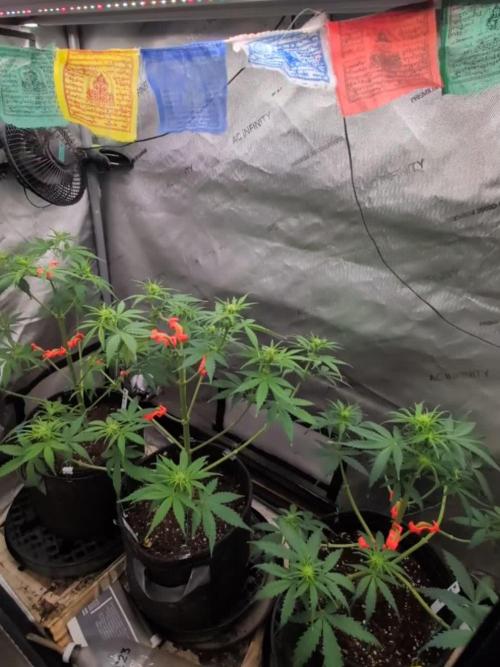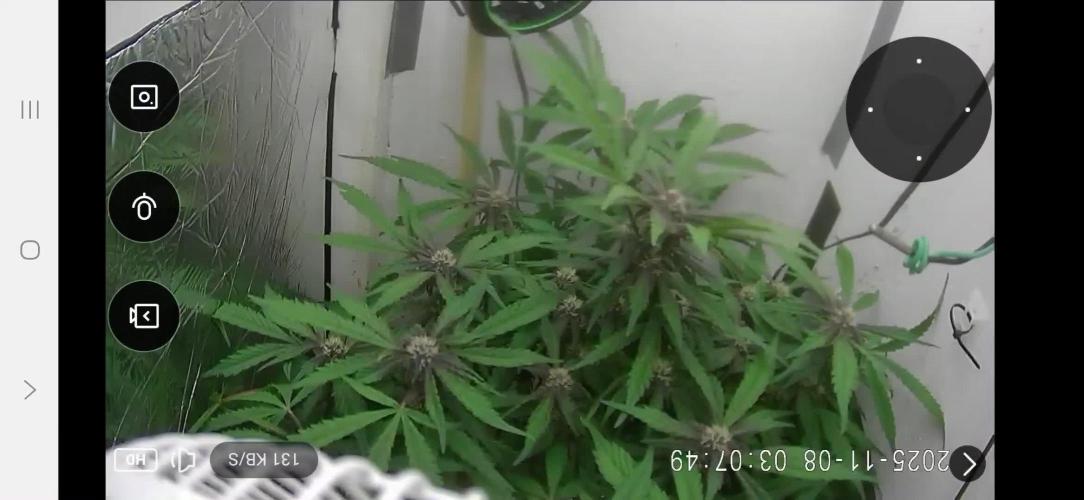The Grow Awards 2026 🏆 





























Likes
Comments
Share


@Salokin
Follow
Hello Growmies,
The time has come—harvest week is here for our G.M.O. #1 and G.M.O. #2! These plants have completed their journey, and the Mars Hydro FC-4800 at 55% has been the perfect companion throughout. The consistent flushing with water only has ensured a clean finish, ready for harvest.
G.M.O. #1 stands tall with its central cola a dense, resinous marvel. The pungent aroma fills the air, signaling the potency within. The foliage remains a rich green, and the trichomes are a perfect milky white, indicating that these buds are ready for harvest. The bud sites are swollen and heavy, promising a generous yield.
G.M.O. #2 continues to impress with its unique structure. The top cola is a tower of resin, surrounded by equally impressive satellite buds. The green hues on the leaves reflect perfect light absorption and nutrient balance. The lateral branches are heavily laden with buds, showing significant weight and density. The slight curvature in the stems adds a final touch of wild elegance.
Based on the attached pictures, the plants look exceptionally healthy and ready. The wet weight of the combined harvest is an impressive 800 grams, with G.M.O. #1 contributing 200 grams and G.M.O. #2 a remarkable 600 grams. The smell is absolutely delightful, reminiscent of juicy fruit bubble gum, filling the air with a sweet and enticing aroma.
The meticulous care and attention over the past weeks have culminated in this moment. The journey of G.M.O. #1 and G.M.O. #2 has been remarkable, and I'm thrilled to share the final results with you all. The rich, flavorful yield promises to be worth the wait.
Stay lifted,
Salokin
Likes
1
Share


@Jmaninthemidde420
Follow
During veg I gave it urine for nitrogen one month after sprouting. Than I gave it a top feeding of compost, and epsom salt. During bloom I gave it a top feeding of epsom salt and a liquid feeding of raw coconut water 2 weeks into bloom and again 4 1/2 weeks into bloom and now I am only giving it water ph at 6.2. Also if u want to keep it totally organic use apple cider vinegar as ph down and baking soda as ph up.
Likes
245
Share


@Roberts
Follow
Germination has been successful and THC Bomb auto is off and growing. So far everything is going really good. Off to a great start
Thank you grow diaries community for the likes, follows, comments, and subscriptions on my YouTube channel 🌱🌱🌱
Likes
16
Share


@willertex
Follow
📅 D85- 26/01
📜 Only fresh water from now on. She's not yet ready - 3-4 days more I think.
✍️ 0.1 EC
♒ 6 pH
🌊 10 L
📏 95 cm
📅 D90- 29/01
📜 Not yet Ready
✍️ 0.1 EC
♒ 6 pH
🌊 10 L
📏 95 cm
Processing
Likes
10
Share


@Barcelona_Farmers710
Follow
Muy Buenas señores! seguimos a la espera del equipo Led, Entramos en semana 2 de Flora con muy buen color esperemos conseguir mantener esa línea...las Royal Gorila están verdaderamente monstruosas, esta tanda pondremos menos fertilizantes por usar Mykos. Empieza lo bueno en breves veremos que tal va la resina con este calor. Salut e força al canut Farmers!
Likes
4
Share


@Rider420
Follow
🌿
Week 17
Blooming proceed very good, flowers are healthy and roots too 👊🏻
Past weeks was really stressful, now it seems back to its original power ⚡️
Size 📐
length 90cm
width 60cm
height 48cm
Likes
14
Share


@Auto_lover
Follow
She throwing tons of bud sites and still stretching alittle. Really starting to smell.👃 i’ve never had a plant start to stink this early
Day 38 another small defoi
Likes
27
Share


@LockDownGrow
Follow
well this lady has been a gem too work with , she really stretched out at flower growing from a rose into too a sun flower lol but not quiet as tall as her sister the cali snow ,
she has been no trouble at all so far no deficiency's at all , also her bud structure is forming nicely and again not too far behind the cali snow ,
but both plants have almost identical structures too each other until you rub your fingers on those sugar leaves and they tell you they are doing there own thing by the lush sent they leave you sniffing your fingers in delight , the cali snow has much more of a friuty smell than the GSC but they both smell delicious thats for sure
Likes
1
Share


@kauilmayel1996
Follow
Creciendo bastante bien
Talvez yo no sé cómo hacer el lst pero está aguantando bastante bien está nena
En un semana creció bastante!!!
Estoy contento
Me está aguantando
Ok
Sábado
No sé si el lst ayuda al crecimiento pero siento que va a avanzando mucho...
No tengo ni idea de que estoy haciendo ni estaba preparado para hacer amarres
Ni tengo idea de cómo lo voy a hacer... Pero realmente quería experimentar ya que veo que todos lo hacen aún que me da miedo romper la planta o estresar la y tampoco se que cortar!!! 😔
Likes
5
Share


@Vincent_Van_Grogh
Follow
D34, 12 Oct, Sunday
♥️ 2.2 L 💛2.1 L 💚 1.9 L
CalMag, GrowBig, BigBloom, TigerBoom
Finally started bottom feeding, which makes things easier.
Defoliated a bunch and lollipop for better air and exposure.
A lot slower in growth than Mephisto genetics. But let's see.
D37, 15 Oct, Wednesday
♥️ 2.7L 💛2.5 L 💚 2.2 L
All with just Recharge and nothing else.
CalMag and/or K def on ♥️ and 💛.
Let's see if it can still be fixed.
Processing
Likes
39
Share


@G4NJAG4NG
Follow
Day 57 Day 15 flower - what can I say? No issues reported so far, did some more defoliation below the scrog and tidied up some of the flower sites, removed a few of the old fan leaves and checked on Zkittlez OG, she is frosty already and starting to look really sparkly and beautiful 💎😍
The others are also showing some frost and bud development is going well!! Exciting times ahead!
290319 day 59 flower day 17 - no issues apart from slight heat stress for the girl in the middle, will adjust the light tomorrow to ease the stress. Bud candy just arrived so I will add 1ml/l on next feed tomorrow morning! Overall the bud sites have came through in numbers and are looking very strong and healthy, OG Zkittlez auto has turned into diamonds of trichomes and the others are following suite 😍 more updates to come! Hopefully skittlez is finished in the next 3 weeks! Also added a rotating flow to get good air flow in the tent, there were some dead spots.
020419 day 63 flower day 21
Likes
3
Share


@goatpharms
Follow
MAC is at peak maturity — buds are dense, vibrant, and resin-coated, displaying rich shades of purple, orange, and deep green. The aroma is strong and pungent (you would no it's mac straight away from the nose) , indicative of excellent terpene development. Plant health is optimal across the canopy, and all signs point to harvest readiness. Chopping her tommrow 💚
Likes
30
Share


@Kloud9gardenz
Follow
She picked up a lot of spider mites out of nowhere when I didn't have any during veg. Did a heavy neem treatment and defoliation so hopefully that will take care of it. Buds are still getting fat and I'll wait to see how it goes in the last 4 weeks.
Likes
32
Share


@MadeInGermany
Follow
Info:
Unfortunately, I had to find out that my account is used for fake pages in social media.
I am only active here on growdiaries.
I am not on facebook instagram twitter etc All accounts except this one are fake.
Hey everyone ☺️.
She developed very well 👍.
In the next 10-14 days she will be in the bloom tent :-).
1 g Enhancer Pro l cocos was added.
As always, a cuttings are cut before moving 👍.
Otherwise everything was cleaned and checked.
Have fun and stay healthy 🙏🏻
You can buy this Strain at :
www.Zamnesia.com
Type:
Runtz
☝️🏼
Genetics:
Zkittlez x Gelato
👍
Vega lamp: 2 x Todogrow Led
Quantum Board 100 W
💡
Bloom Lamp : 2 x Todogrow Led
Cxb 3590 COB 3500 K 205 W
💡💡☝️🏼
Soil : Bio Bizz Coco
☝️🏼
Nutrients : Green House Seeds Company Powder Feeding Bio
☝️🏼🌱
Water: Osmosis water mixed with normal water (24 hours stale that the chlorine evaporates) to 0.2 EC. Add Cal / Mag to 0.4 Ec Ph with Organic Ph - to 5.8
Processing
Likes
7
Share


@x_grower
Follow
Last week, first of flowering, was outstanding, I could water the girls regulary and the work paid off they stretched a lot and are looking super healthy. The girl right below the upper fan is suffering a bit with the shadows and is notoriously shorter than her sisters, I will need to rethink the air circulation for the next grow. Another concern of mine is their height, hoping they dont stretch anymore as the lights are already at maximum possible height inside tent and there is only 20cm gap between it and the plants.
























